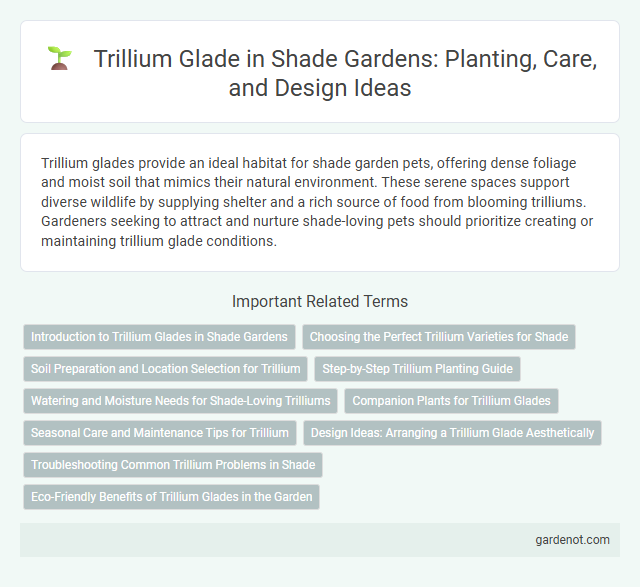Trillium glades provide an ideal habitat for shade garden pets, offering dense foliage and moist soil that mimics their natural environment. These serene spaces support diverse wildlife by supplying shelter and a rich source of food from blooming trilliums. Gardeners seeking to attract and nurture shade-loving pets should prioritize creating or maintaining trillium glade conditions.
Introduction to Trillium Glades in Shade Gardens
Trillium glades are specially designed areas within shade gardens that replicate the natural woodland habitat favored by Trillium species. These glades provide rich, well-drained soil and dappled sunlight essential for Trillium's growth and flowering. Incorporating native Trillium varieties like Trillium grandiflorum or Trillium erectum enhances biodiversity and creates visually striking understory displays.
Choosing the Perfect Trillium Varieties for Shade
Selecting the perfect Trillium varieties for a shade garden requires focusing on species like Trillium grandiflorum, Trillium erectum, and Trillium nivale, which thrive in low-light environments. These varieties prefer well-drained, humus-rich soil and consistent moisture, making them ideal for woodland settings. Planting Trillium in clumps enhances their natural beauty and supports pollination, ensuring a vibrant, thriving shade garden.
Soil Preparation and Location Selection for Trillium
Trillium glades thrive in well-drained, humus-rich soil with a slightly acidic to neutral pH (5.5 to 7.0), mimicking their natural woodland habitat. Selecting a shaded location under deciduous trees ensures dappled sunlight and protection from harsh afternoon sun, essential for healthy growth and vibrant blooms. Proper soil preparation involves incorporating organic matter such as leaf mold or compost to enhance moisture retention and nutrient availability.
Step-by-Step Trillium Planting Guide
Selecting a well-drained, humus-rich soil site with partial to full shade is essential for a thriving Trillium glade. Plant Trillium rhizomes 2 to 4 inches deep and space them 12 to 18 inches apart to allow for natural spreading. Consistent moisture and a thick layer of leaf mulch help mimic woodland conditions and promote healthy growth.
Watering and Moisture Needs for Shade-Loving Trilliums
Trillium glade thrives in consistently moist, well-drained soil rich in organic matter, making regular watering essential, especially during dry spells. Maintain soil moisture without waterlogging by applying a 2-3 inch layer of mulch to retain humidity and regulate temperature. These shade-loving trilliums perform best in environments with high humidity and indirect sunlight, ensuring optimal growth and vibrant blooms.
Companion Plants for Trillium Glades
Trillium glades thrive in shaded, moist environments, making companion plants like ferns, hostas, and wild ginger ideal for enhancing their natural habitat. These companions share similar soil and light preferences, promoting healthy growth and reducing competition. Integrating native shrubs such as rhododendrons and mountain laurels further supports biodiversity and aesthetic appeal in Trillium glades.
Seasonal Care and Maintenance Tips for Trillium
Trillium glade thrives in well-drained, humus-rich soil with consistent moisture throughout the growing season. To maintain healthy growth, mulch annually with organic material to retain soil moisture and suppress weeds. Pruning spent foliage in late autumn prevents disease and encourages vigorous flowering the following spring.
Design Ideas: Arranging a Trillium Glade Aesthetically
Arranging a Trillium glade involves grouping clusters of Trillium plants to create natural-looking drifts that mimic woodland understories. Incorporate varying heights and complementary shade plants such as ferns and hostas to enhance textural contrast while maintaining a serene, shaded ambiance. Use organic mulch and curved pathways to guide visitors gently through the glade, emphasizing the delicate beauty of the Trillium blooms.
Troubleshooting Common Trillium Problems in Shade
Trillium glades thrive in consistently moist, well-drained shade environments but can suffer from root rot if soil drainage is poor. Yellowing leaves often indicate nutrient deficiencies or exposure to too much direct sunlight, stressing the plant. Regularly mulching with organic matter and monitoring soil moisture levels helps prevent common issues like fungal diseases and wilting in these shade-loving perennials.
Eco-Friendly Benefits of Trillium Glades in the Garden
Trillium glades contribute to eco-friendly gardening by providing natural habitats that support pollinators like bees and butterflies, enhancing biodiversity in shaded areas. Their low water requirements and resistance to pests reduce the need for chemical fertilizers and pesticides, promoting sustainable garden practices. These native plants also improve soil health through leaf litter decomposition, enriching the ecosystem without artificial inputs.
Trillium glade Infographic

 gardenot.com
gardenot.com